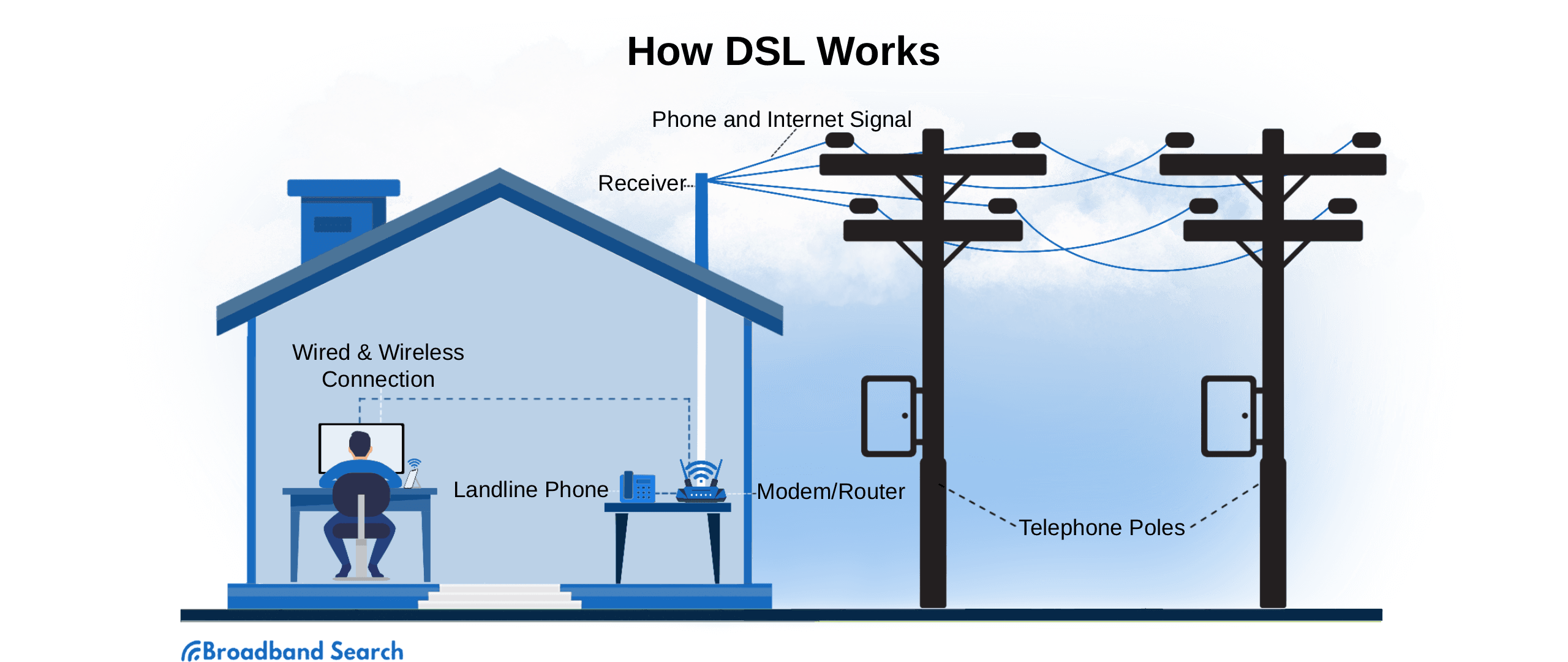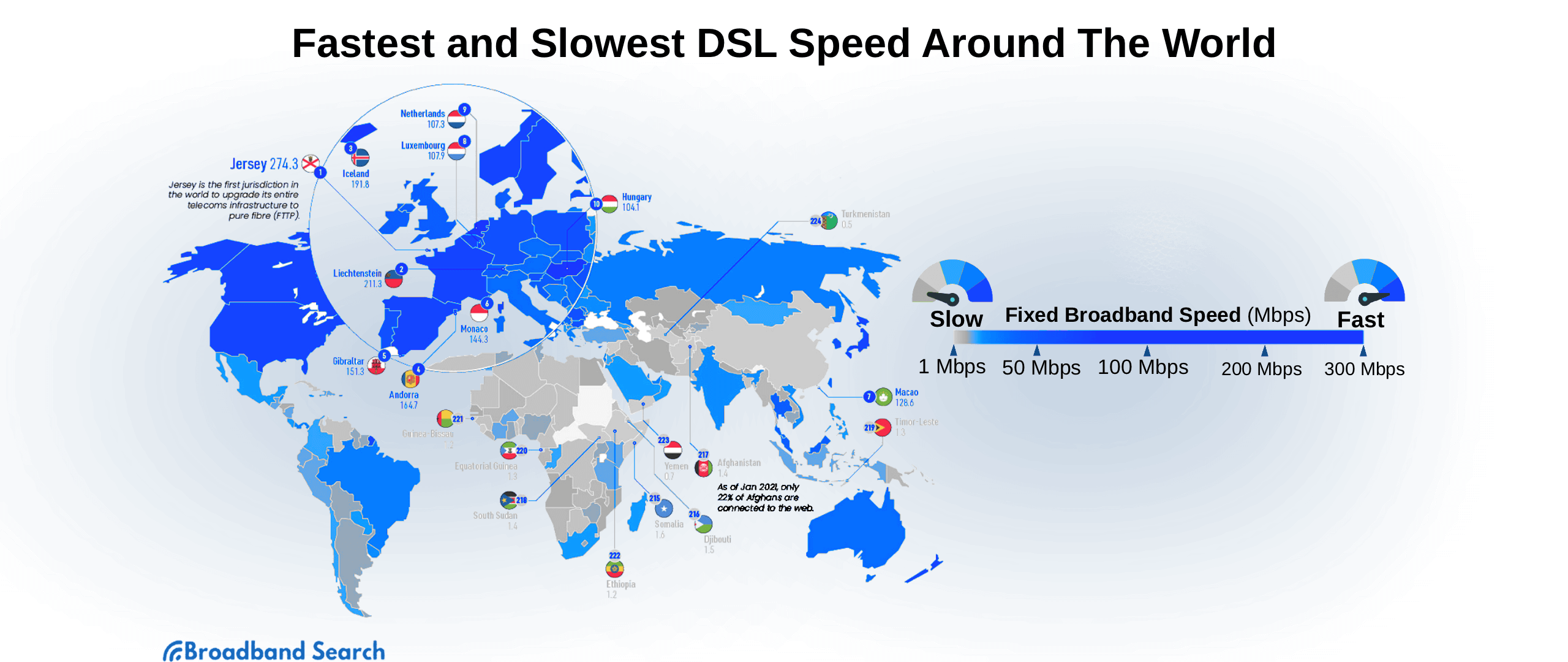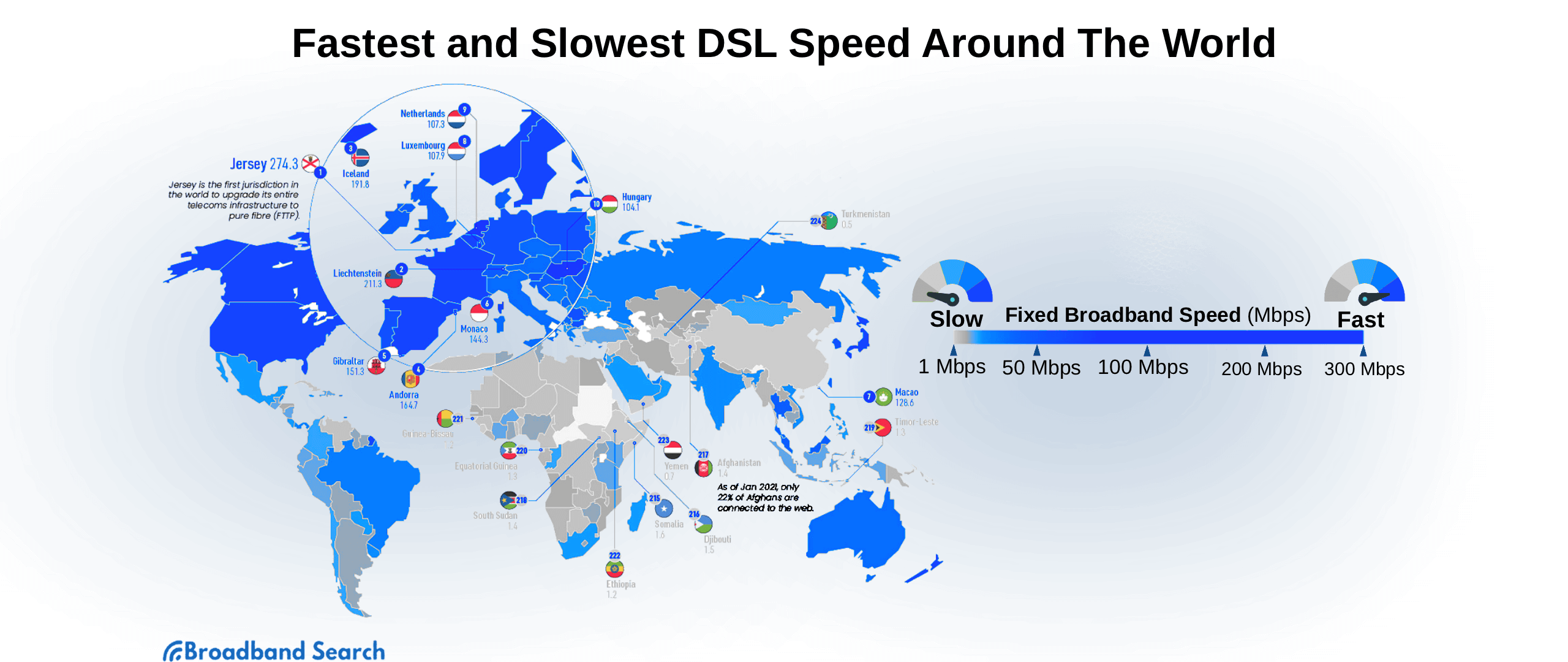Not everywhere has access to the internet. Many parts of the world have limited internet connection options. Satellite internet might be an option in some areas, but not everywhere is covered, and the service can be prohibitively expensive. And while other service types are in development and the infrastructure is getting built, it could be years before significant progress is made.
However, one option that remains among the most popular in the world is DSL internet, which utilizes phone lines (and phone lines are practically in every developed area). It is often cheap, easy to get going, and is currently used by millions, if not hundreds of millions, to access the internet daily. Yet what is DSL internet? How does it work? Is it an option for you? Let’s examine these questions and more below:
What You Need to Know About DSL
There is a lot of information available about DSL internet and services. While we cannot possibly go over all of it (that would take books), here is the general information we think is the most important for you to know:
Definition of DSL
DSL is a primary form of broadband internet access in the world that utilizes phone lines to transfer information. It is one of several types of broadband internet connection, and note that it is not the only type of broadband connection (some people mix this up). It utilizes the many frequencies that telephone lines can handle that aren’t used by one’s home phone line. This differentiates it from dial-up, and DSL will not disrupt telephone service.
DSL stands for digital subscriber line and comes in several forms (more on those next section). It first became available to the average user in the 1990s and was both a huge step up from dial-up and the best option for internet for most people at the time. Now, while other forms of the internet are taking the spotlight, DSL continues to be the backbone of our online communication.
Types of DSL
There is more than one type of DSL service, and there are distinctions between them. Collectively they are known as xDSL. While you don’t need to know these on a day-to-day basis to get service, this information can help you better understand your connection and the developments DSL has had over the years.
There are three major types, as explained below:
ADSL: Asymmetric DSL provides transmission frequencies between 9 Mbps downstream over a very short distance (640kbps upstream) and about 1.544 Mbps downstream up to about 18,000 feet away. Each has uses depending on whether a user has commercial or residential needs. ADSL has quite a large capacity and is focused more on people needing to download more information. That being said, it is slow compared to most other DSL connections, though it can be capable of download speeds up to 20 Mbps and upload speeds up to 1.4 Mbps.
SDSL: Symmetric DSL splits the incoming and outgoing frequencies equally (unlike ADSL), making it a better option for those needing to upload. It is also called HDSL2 and can provide T1 speeds (1.54 Mbps) for distances reaching 10,000 feet. It is a single-wire variant.
VSDL: Standing for very-high-speed digital subscriber line, VDSL is the best option for consumer use if it is available and is generally the option found from DSL providers in the United States to stay competitive with other options and meet the needs of users. It is an upgrade to the previously used HDSL and uses very high frequencies, allowing download speeds of up to 52 Mbps and upload speeds of up to 16 Mbps (even if these aren’t always reached).
There is also VSDL2, which is capable of upload and download speeds of 100 Mbps and is the best that DSL has to offer to the average user.
How DSL Works
Sure, DSL works by utilizing existing phone lines, but there’s more to it than that. Generally, a DSL modem will receive signals via telephone lines. It converts these signals digitally for you and your household to use (perhaps moving them forward to a router if you have a WiFi network setup). It is a dedicated connection and works between the network service provider and the local recipient (or perhaps a loop in the case of a larger apartment complex or office building). The specifics of the lines, the speed of the connection, and other factors can vary based on the DSL technology used and other elements.

Copper wires used in telephone lines can do much more than just transmit that information, and that’s what DSL is based on. Telephone lines can handle many (thousands) different frequencies all at once. While a handful are used for telephone service, the rest can be used to transmit information and allow people to stay online with the help of a modem or modem/router combo. This device connects to multiple computers or devices at once to deliver service in a usable form. And as mentioned above, there are a few common forms of DSL service, often revolving around the split between upload and download speeds.
Interestingly, DSL isn’t slowed down by the number of users in an area. However, the signal degrades over time, leading to situations where people closer to the network service provider or station can have a much better and faster connection than those farther away.
How Fast is DSL
While DSL was faster than other options that came before it and can still compete with other options today, how fast is it? It is one of the oldest types of internet connection that can provide high-speed internet, but how does it compare? Here are some of the details and numbers:
What is the Typical Speed Range of DSL
Naturally, there will be variations in the speed of DSL service, but usually, people can expect 1-7 Mbps for basic DSL service. This makes it suitable for basic tasks such as checking email and simple web browsing. DSL is considered high-speed internet compared to some of the methods before it. However, it doesn’t compare well to other options today, such as fiber and most cable internet setups. Note that there are variants of DSL service, and the typical 1-7 Mbps isn’t the case for everyone. You’ve probably seen advertisements for DSL service that offers higher speeds.
If you’re interested in service, you will want to look in your area regarding what has been advertised and the actual speeds.
You can use this site and local boards and forums to help collect all the information on speeds in your area.
What is High-Speed DSL
On top of regular DSL service, there is also high-speed DSL, which many people in the United States might be used to. Simply put, some DSL providers can offer better service than others based on the infrastructure available to them and the investments they have made. If high-speed DSL is in your area currently, note that it is likely working off of a VDSL or VDSL2 setup, as mentioned above.
DSL providers can often provide different tiers with different speeds or amounts of bandwidth. Common options include 12 Mbps, 20 Mbps, 45 Mbps, or even up to 100 Mbps in a few circumstances. Upload speeds, unfortunately, will remain mostly low. We may not see speeds top this for some time, if ever, due to technical limitations, but with any luck and some planning, it might be possible that the higher speeds will be accessible to more people worldwide.
Fastest DSL Speeds in the World
While there are practical limitations for DSL speeds for most of the world (infrastructure, signal loss, etc.), what is the fastest speed DSL can provide? Have technological advancements improved DSL speeds, at least in theory, if not in widely implemented practice?

According to the information we could find, the absolute fastest speed through DSL is 400 Mbps download speed. The fastest upload speeds hover around 8 Mbps, though there are exceptions that reach 232 Mbps (in theory, if not in practice). Note that these speeds are exceptionally rare but demonstrate that the technology is progressing. VDSL2 setups are becoming more common, allowing more connections that can reach 100 Mbps download speed. Some providers are even advertising internet speeds that range above 100 Mbps, such as Kinetic and CenturyLink.
Of additional note is that some providers offer “hybrid” DSL service that overlaps with other service types and will generally have higher speeds than just DSL service. This is a newer development, so it is difficult to say where it might be heading.
Conclusion
While DSL doesn’t get much press for being the best and most advanced option, it is one of the most popular ways people access the internet and will be for some time. We hope you have a much better understanding of DSL technology, DSL services around the globe, and the fastest DSL speed available for yourself and around the world. It might or might not be for you or even available to you, but this knowledge will help you better understand our modern world. Thank you for reading, and we encourage you to return to this page as you feel the need.
FAQ
How much does DSL cost?
It can depend on the plan you get and the location where you live. Other factors, such as discounts, bundles, and equipment costs, can also come into play. However, a reasonable estimate for DSL service is $50 per month. Some plans are cheaper, and some are much more expensive, so be sure to carefully look at your options if you are interested.
Is DSL good for gaming?
It depends on the DSL plan. There is nothing inherent about DSL that makes it bad for gaming, though some plans and connections might be too slow for the best experience.
We recommend at least 25 Mbps of download speed, 5 Mbps of upload speed, and 70 ms or less latency for gaming. You can likely get away with worse specifications on your connection, but you might run into some hiccups.
What is the best DSL provider?
That is up to interpretation, and you might want to consider “what is the best DSL provider in my area?”. Often providers can vary significantly from region to region, and an excellent DSL provider in New England might not be so great in the South. Furthermore, some might be best for different things. One might be best regarding availability, while another might be best in value. Another still might be best when it comes to performance. Consider your priorities and search out options with those in mind.
Is DSL faster than 5G?
It can be, but for the most part, it is not. 5G can be tricky to realistically measure the average speed of, but in the United States, they can hover around 50 Mbps on average and go up to 100-300 Mbps with a fixed wireless home setup. DSL speeds can be faster than this, but this is rarely the case and not the everyday experience for most users.
How can I make my DSL connection faster?
Outside of calling your provider and inquiring about a better plan (or switching DSL providers if there’s more than one option), there’s little you can do to make your DSL connection faster. However, you can optimize the connection you have and utilize it better. Some options include ensuring your equipment is working perfectly, pausing background tasks for later (when you aren’t online), and keeping your router in the best location in your home.

